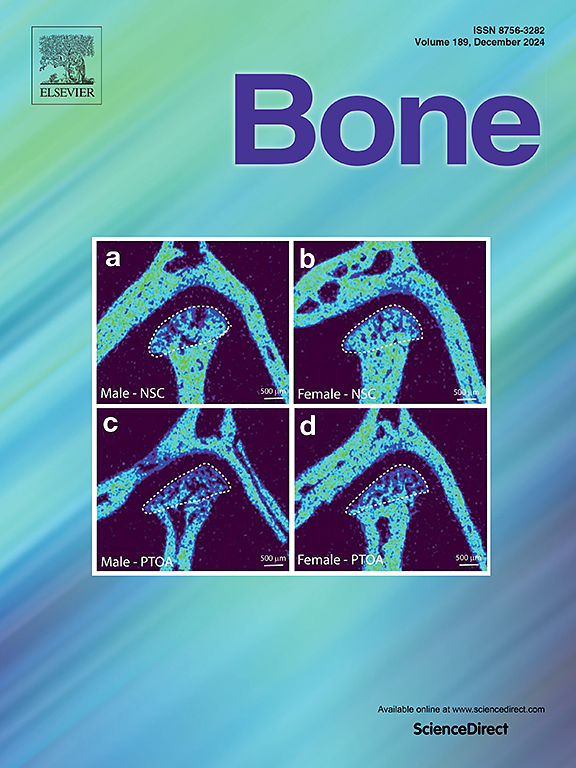离体光子计数计算机断层扫描腕骨微结构分割和定量的准确性和精密度。
IF 3.5
2区 医学
Q2 ENDOCRINOLOGY & METABOLISM
引用次数: 0
摘要
骨微结构的量化提供了对骨骼健康和疾病或治疗效果的深入了解,因此是高度相关的临床信息。尽管如此,骨微结构的体内定量大多局限于高分辨率外周定量CT (HR-pQCT)。这是一种小视野的CT模式,其龙门尺寸仅允许扫描桡骨远端和胫骨。光子计数CT (PCCT)是一种新型的临床全身CT,与其他临床CT方式相比,它具有更高的图像分辨率和质量,但有关其量化骨微结构能力的数据有限。本研究的目的是量化两种方法在PCCT图像上的骨小梁分割与微ct (μCT)上的分割的准确性,并使用这些分割来量化与μCT相比的骨小梁形态测量的准确性和一致性,以及短期精度。本研究分析了8具尸体前臂的多模态CT数据;数据包括两次重复的PCCT扫描,以及前臂的单次HR-pQCT扫描,以及所有个体腕骨的μCT扫描。对每个腕骨在μCT图像上勾画出感兴趣的小梁体积(VOI),并将μCT参考分割和VOI重新采样到PCCT和HR-pQCT图像上。HR-pQCT图像分割的全局阈值为320 mgHA/cm3;采用相同的全局阈值或自适应阈值算法对PCCT图像进行分割。对所有节段性VOIs进行骨小梁体积分数(Tb.BV/TV)、骨小梁厚度(Tb.Th)、骨小梁数量(Tb.N)和骨小梁间距(Tb.Sp)的量化。以μCT为金标准计算准确度和一致性,以PCCT重复扫描计算短期精密度。对于PCCT,与全局阈值分割相比,自适应阈值分割的敏感性显著提高,敏感性和特异性差异较小。在微结构量化方面,对于PCCT图像的全局阈值分割,除tbsp外,其余均与μCT相关。Tb的相关系数。BV/TV和Tb。HR-pQCT和μCT的N值差异不显著。自适应阈值分割使PCCT与Tb的μCT具有较高的相关系数。Th,结核病。N和Tb。Sp,尽管Tb的相关性。PCCT和HR-pQCT的N值都很低。此外,自适应阈值导致Tb的恒定偏差。BV /电视,结核病。Th和Tb。Sp,不像HR-pQCT的偏倚随着测量的大小成比例地增加。最后,自适应阈值分割的短期精度高于全局阈值分割,所有参数的均方根变异系数均低于0.65 %。我们得出结论,自适应阈值分割非常适合于PCCT图像的分割。尽管存在测量误差,但我们的结果表明,这些分割可以用于腕骨的骨微结构分析,具有与HR-pQCT相当的一致性和短期精度。本文章由计算机程序翻译,如有差异,请以英文原文为准。
Accuracy and precision of segmentation and quantification of wrist bone microarchitecture using photon-counting computed tomography ex vivo
The quantification of bone microarchitecture provides insight into bone health and the effects of disease or treatment, and is therefore highly relevant clinical information. Nonetheless, in vivo quantification of bone microarchitecture is mostly limited to high-resolution peripheral quantitative CT (HR-pQCT). This is a small field of view CT modality of which the gantry size only allows scanning of distal radius and tibia. Photon-counting CT (PCCT) is a novel clinical full-body CT with improved image resolution and quality compared to other clinical CT modalities, yet data on its capabilities in quantifying bone microarchitecture are limited. The aim of this study was to quantify the accuracy of two methods for trabecular bone segmentation on PCCT images as compared to the segmentations on micro-CT (μCT) and to use these segmentations to quantify the accuracy and agreement of trabecular bone morphometry measurements as compared to μCT, as well as the short-term precision.
This study analysed multimodal CT data, obtained from eight cadaveric forearms; the data includes two repeated PCCT scans, as well as a single HR-pQCT scan from the forearm, and μCT scans of all individual carpal bones. For each carpal bone, trabecular volumes of interest (VOI) were delineated on the μCT images, and the μCT reference segmentations and VOIs were resampled onto the PCCT and HR-pQCT images. HR-pQCT images were segmented with a global threshold of 320 mgHA/cm3; PCCT images were segmented with either an identical global threshold or with an adaptive thresholding algorithm. Trabecular bone-volume fraction (Tb.BV/TV), trabecular thickness (Tb.Th), trabecular number (Tb.N) and trabecular separation (Tb.Sp) were quantified for all segmented VOIs. Accuracy and agreement were calculated relative to μCT as the gold standard, short-term precision was calculated from the repeated PCCT scan.
For PCCT, adaptive threshold segmentation had significantly increased sensitivity compared to global threshold segmentation, along with a lower variance in its sensitivity and specificity. Concerning the microarchitecture quantification, for global threshold segmentation of PCCT images, correlations with μCT were significant, except for Tb.Sp. Correlation coefficients of Tb.BV/TV and Tb.N were not significantly different from those between HR-pQCT and μCT. Adaptive threshold segmentation led to higher correlation coefficients between PCCT and μCT of Tb.Th, Tb.N and Tb.Sp, although correlations of Tb.N remained poor for both PCCT and HR-pQCT. Moreover, adaptive thresholding led to a constant bias of Tb.BV/TV, Tb.Th and Tb.Sp, unlike the bias of HR-pQCT which was proportionally increasing with the size of the measurement. Finally, adaptive threshold segmentation led to a higher short-term precision than global threshold segmentation, with a root-mean-squared coefficient of variation below 0.65 % for all parameters.
We conclude that adaptive threshold segmentation is well-suited for the segmentation of PCCT images. Despite measurement error, our results indicate that these segmentations can be used for bone microarchitecture analyses of carpal bones with agreement and short-term precision comparable to HR-pQCT.
求助全文
通过发布文献求助,成功后即可免费获取论文全文。
去求助
来源期刊

Bone
医学-内分泌学与代谢
CiteScore
8.90
自引率
4.90%
发文量
264
审稿时长
30 days
期刊介绍:
BONE is an interdisciplinary forum for the rapid publication of original articles and reviews on basic, translational, and clinical aspects of bone and mineral metabolism. The Journal also encourages submissions related to interactions of bone with other organ systems, including cartilage, endocrine, muscle, fat, neural, vascular, gastrointestinal, hematopoietic, and immune systems. Particular attention is placed on the application of experimental studies to clinical practice.
 求助内容:
求助内容: 应助结果提醒方式:
应助结果提醒方式:


